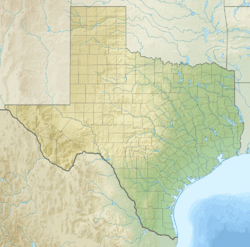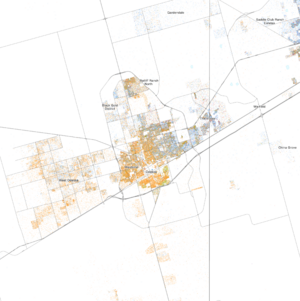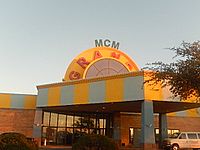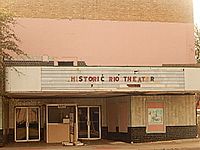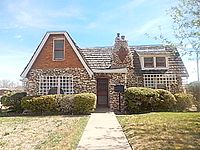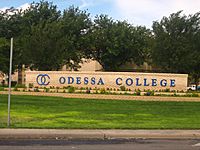Odessa, Texas facts for kids
Quick facts for kids
Odessa, Texas
|
||
|---|---|---|

Odessa skyline, looking east from TX-302
|
||
|
||

Location in Texas
|
||
| Country | United States | |
| State | Texas | |
| Counties | Ector, Midland | |
| Named for | Odesa (historically also spelled "Odessa"), Ukraine | |
| Government | ||
| • Type | Council-Manager | |
| Area | ||
| • Total | 51.36 sq mi (133.02 km2) | |
| • Land | 51.08 sq mi (132.29 km2) | |
| • Water | 0.28 sq mi (0.72 km2) | |
| Elevation | 2,900 ft (884 m) | |
| Population
(2020)
|
||
| • Total | 114,428 | |
| • Density | 2,414.62/sq mi (932.29/km2) | |
| Time zone | UTC−6 (CST) | |
| • Summer (DST) | UTC−5 (CDT) | |
| ZIP Codes |
79760–79769
|
|
| Area code(s) | 432 | |
| FIPS code | 48-53388 | |
| GNIS feature ID | 1343067 | |
Odessa is a city in Texas, a state in the United States. It is the main city of Ector County, and parts of it also reach into Midland County. In 2020, about 114,428 people lived there, making it one of the largest cities in Texas.
Odessa is well-known because it was featured in the book and movie called Friday Night Lights. This story is about a high school football team. The city was also once home to former Presidents George H. W. Bush and George W. Bush.
Contents
History of Odessa
Odessa started in 1881 as a place where trains could stop for water. It was also a spot for shipping cattle. The first post office opened in 1885. Odessa became the main town of Ector County in 1891.
The city officially became a city in 1927. This happened after oil was found nearby. When more oil fields opened in 1929 and 1930, many new people moved to Odessa. The population grew from 750 in 1925 to 5,000 by 1929.
For the rest of the 1900s, Odessa's population and economy grew very fast during times when oil prices were high. These times are called "oil booms." When oil prices dropped, the city's economy would slow down.
Why is it Called Odessa?
Odessa is thought to be named after Odesa, a city in Ukraine. The flat, grassy land around Odessa, Texas, looked a lot like the wide plains in Ukraine.
Geography and Climate
Odessa is located in West Texas, on the edge of a flat area called the Llano Estacado. It sits above the Permian Basin. This area has huge amounts of oil and natural gas deep underground.
The city covers about 44 square miles (114 square kilometers). Most of this area is land, with a very small part covered by water.
Odessa's Weather
Odessa has a hot semiarid climate. This means summers are hot and sunny. Winters are cool and dry. Most of the rain falls in late spring and summer. Snow is not very common. The temperature can change a lot between day and night. The area also often has strong winds.
| Climate data for Odessa, Texas, 1991–2020 normals, extremes 1950–present | |||||||||||||
|---|---|---|---|---|---|---|---|---|---|---|---|---|---|
| Month | Jan | Feb | Mar | Apr | May | Jun | Jul | Aug | Sep | Oct | Nov | Dec | Year |
| Record high °F (°C) | 83 (28) |
89 (32) |
99 (37) |
101 (38) |
113 (45) |
112 (44) |
110 (43) |
109 (43) |
110 (43) |
102 (39) |
88 (31) |
85 (29) |
113 (45) |
| Mean maximum °F (°C) | 76.0 (24.4) |
80.4 (26.9) |
87.1 (30.6) |
93.6 (34.2) |
100.1 (37.8) |
104.0 (40.0) |
101.6 (38.7) |
101.5 (38.6) |
97.3 (36.3) |
91.4 (33.0) |
81.6 (27.6) |
74.8 (23.8) |
105.6 (40.9) |
| Mean daily maximum °F (°C) | 56.9 (13.8) |
62.0 (16.7) |
70.8 (21.6) |
79.3 (26.3) |
86.6 (30.3) |
94.0 (34.4) |
94.0 (34.4) |
92.9 (33.8) |
85.3 (29.6) |
77.0 (25.0) |
66.0 (18.9) |
57.9 (14.4) |
76.9 (24.9) |
| Daily mean °F (°C) | 44.6 (7.0) |
49.1 (9.5) |
57.4 (14.1) |
65.1 (18.4) |
73.8 (23.2) |
81.0 (27.2) |
82.4 (28.0) |
81.4 (27.4) |
73.8 (23.2) |
65.1 (18.4) |
53.7 (12.1) |
45.6 (7.6) |
64.4 (18.0) |
| Mean daily minimum °F (°C) | 32.2 (0.1) |
36.2 (2.3) |
44.0 (6.7) |
50.9 (10.5) |
61.0 (16.1) |
68.1 (20.1) |
70.8 (21.6) |
69.9 (21.1) |
62.4 (16.9) |
53.1 (11.7) |
41.4 (5.2) |
33.3 (0.7) |
51.9 (11.1) |
| Mean minimum °F (°C) | 19.1 (−7.2) |
22.0 (−5.6) |
29.4 (−1.4) |
37.1 (2.8) |
46.1 (7.8) |
61.4 (16.3) |
63.8 (17.7) |
63.6 (17.6) |
52.9 (11.6) |
37.6 (3.1) |
25.8 (−3.4) |
20.7 (−6.3) |
14.0 (−10.0) |
| Record low °F (°C) | 2 (−17) |
−5 (−21) |
16 (−9) |
22 (−6) |
31 (−1) |
50 (10) |
55 (13) |
53 (12) |
43 (6) |
15 (−9) |
11 (−12) |
5 (−15) |
−5 (−21) |
| Average precipitation inches (mm) | 0.68 (17) |
0.54 (14) |
0.67 (17) |
0.70 (18) |
1.62 (41) |
1.00 (25) |
1.47 (37) |
1.61 (41) |
1.53 (39) |
1.27 (32) |
0.61 (15) |
0.58 (15) |
12.28 (311) |
| Average snowfall inches (cm) | 0.2 (0.51) |
0.2 (0.51) |
0.0 (0.0) |
0.0 (0.0) |
0.0 (0.0) |
0.0 (0.0) |
0.0 (0.0) |
0.0 (0.0) |
0.0 (0.0) |
0.0 (0.0) |
0.2 (0.51) |
0.3 (0.76) |
0.9 (2.29) |
| Average precipitation days (≥ 0.01 in) | 3.4 | 3.4 | 3.1 | 2.6 | 3.7 | 3.9 | 4.3 | 4.1 | 5.4 | 3.8 | 2.9 | 2.8 | 43.4 |
| Average snowy days (≥ 0.1 in) | 0.0 | 0.0 | 0.0 | 0.0 | 0.0 | 0.0 | 0.0 | 0.0 | 0.0 | 0.0 | 0.0 | 0.2 | 0.2 |
| Source 1: NOAA | |||||||||||||
| Source 2: National Weather Service | |||||||||||||
People of Odessa
| Historical population | |||
|---|---|---|---|
| Census | Pop. | %± | |
| 1930 | 2,407 | — | |
| 1940 | 9,573 | 297.7% | |
| 1950 | 29,495 | 208.1% | |
| 1960 | 80,338 | 172.4% | |
| 1970 | 78,380 | −2.4% | |
| 1980 | 90,027 | 14.9% | |
| 1990 | 89,699 | −0.4% | |
| 2000 | 90,943 | 1.4% | |
| 2010 | 99,940 | 9.9% | |
| 2020 | 114,428 | 14.5% | |
| U.S. Census Bureau Texas Almanac | |||
Population Changes in Odessa
| Race / Ethnicity (NH = Non-Hispanic) | Pop 2000 | Pop 2010 | Pop 2020 | % 2000 | % 2010 | % 2020 |
|---|---|---|---|---|---|---|
| White alone (NH) | 46,179 | 41,492 | 37,390 | 50.78% | 41.52% | 32.68% |
| Black or African American alone (NH) | 5,165 | 5,330 | 7,007 | 5.68% | 5.33% | 6.12% |
| Native American or Alaska Native alone (NH) | 372 | 445 | 424 | 0.41% | 0.45% | 0.37% |
| Asian alone (NH) | 775 | 1,056 | 2,452 | 0.85% | 1.06% | 2.14% |
| Pacific Islander alone (NH) | 22 | 92 | 258 | 0.02% | 0.09% | 0.23% |
| Some Other Race alone (NH) | 24 | 52 | 357 | 0.03% | 0.05% | 0.31% |
| Mixed race or Multiracial (NH) | 735 | 872 | 2,296 | 0.81% | 0.87% | 2.01% |
| Hispanic or Latino (any race) | 37,671 | 50,601 | 64,244 | 41.42% | 50.63% | 56.14% |
| Total | 90,843 | 99,940 | 114,428 | 100.00% | 100.00% | 100.00% |
In 2020, there were 114,428 people living in Odessa. This included over 41,942 households and 28,218 families. In 2010, the city had 99,940 people.
Many different groups of people live in Odessa. In 2020, about 56% of the people were of Hispanic or Latino background. The city's population has become more diverse over the years.
Odessa's Economy
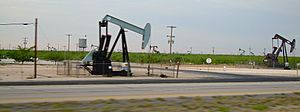
For a long time, Odessa's economy has mostly depended on the oil industry. When oil prices go up, the economy grows fast. When they go down, the economy slows. Many of the biggest companies in Odessa work with oilfield supplies or process chemicals from oil.
Recently, city leaders have been trying to make the economy more diverse. This way, it won't depend so much on oil prices. For example, a wind farm was built in 2009 to create clean energy. There were also plans for a special small nuclear reactor for teaching and testing at the University of Texas of the Permian Basin.
Odessa also has a large shopping mall called Music City Mall. It used to have an indoor ice skating rink.
Major Employers in Odessa
Many of the largest employers in Odessa are in education, government, and healthcare. Outside of these, most big employers are in the oil industry. Here are some of the top employers in 2021:
| # | Employer | Number of employees |
|---|---|---|
| 1 | Ector County Independent School District | 4,163 |
| 2 | Medical Center Hospital | 1,977 |
| 3 | Halliburton | 1,400 |
| 4 | NexTier (formerly Keane Group) | 1,142 |
| 5 | City of Odessa | 900 |
| 6 | Saulsbury Companies | 874 |
| 7 | Odessa Regional Medical Center | 800 |
| 8 | Ector County | 735 |
| 9 | H-E-B | 721 |
| 10 | University of Texas Permian Basin | 619 |
Arts and Culture in Odessa
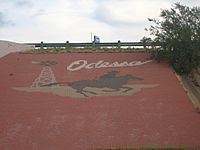

Performing Arts
The Midland–Odessa Symphony and Chorale (MOSC) started in 1962. It is the biggest music group in the area. They perform both popular and classical concerts.
The Globe of the Great Southwest is on the campus of Odessa College. It is a copy of William Shakespeare's Globe Theatre. It puts on plays and has a Shakespeare festival every year. Other theaters in Odessa include the Ector Theater and the Permian Playhouse.
Places to Visit
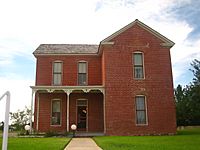
Odessa has a Presidential Museum and Leadership Library. It is on the campus of the University of Texas of the Permian Basin. This museum teaches about the office of the U.S. Presidency. It also has exhibits about the presidents of the Republic of Texas.
The Texon Santa Fe Depot shows what old train stations were like. The Parker House Museum shares the story of a well-known ranching family from the early 1900s.
Southwest of the city, there is the Odessa Meteor Crater. This is a large hole in the ground, about 550 feet (168 meters) wide, made by a meteor hitting the Earth.
Odessa is also known for its 31 jackrabbit statues. These statues are part of an art project that started in 2004.
Libraries in Odessa

- Ector County Library
- Murry H. Fly Learning Resource Center
- The J. Conrad Dunagan Library
Sports in Odessa
Odessa is home to the Odessa Jackalopes, a junior ice hockey team. They play their games at Ector County Coliseum. This arena has also hosted other indoor football teams.
High school football games are played at Ratliff Stadium. This stadium was featured in the movie Friday Night Lights. It is the home field for the Odessa Bronchos and the Permian Panthers. It is one of the largest high school stadiums in Texas.
Education in Odessa
Universities and Colleges
University of Texas Permian Basin
The University of Texas Permian Basin (UTPB) opened in 1973. At first, it only accepted students who had already completed their first two years of college. In 1991, a new law allowed UTPB to accept freshmen and sophomores.
UTPB's School of Business is highly rated. It has a special accreditation from AACSB International. Only a small number of business schools around the world have this honor.
Community Colleges
Odessa College is a public, two-year college in Odessa. It serves students from Ector County and the surrounding area. It opened in 1952. Each year, about 6,000 students take college-level courses. Another 11,000 students take other classes like basic education or community recreation.
Schools for Younger Students
The Ector County Independent School District (ECISD) serves most of Odessa. ECISD started in 1921 by combining seven smaller schools. Today, the district has 38 schools. It includes high schools like Permian High School and Odessa High School.
Parts of Odessa that are in Midland County are served by the Midland Independent School District.
Odessa also has many private schools, such as Montessori Mastery School of Odessa and Odessa Christian School. There are also five charter schools, like Compass Academy Charter School.
Media in Odessa
The main daily newspaper in Odessa is the Odessa American. Many radio stations broadcast in the West Texas area, including Odessa. Some popular stations include KFZX (Classic Rock) and KMRK (Country).
Transportation in Odessa
Airports and Space Travel
Odessa is mainly served by Midland International Air and Space Port (MAF). This airport is in Midland County, but it's located about halfway between downtown Midland and downtown Odessa. It serves many passengers each month. Major airlines like Southwest, United, and American fly from here.
Another airport in Odessa is Odessa-Schlemeyer Field (ODO). This airport is used for general aviation, which means it's mostly for private planes, not large commercial flights.
Roads in Odessa
Major roads that connect Odessa to other places include:
 I-20 (Interstate 20)
I-20 (Interstate 20) Bus. I-20 (2nd Street)
Bus. I-20 (2nd Street) US 385 (Andrews Highway / Grant Avenue)
US 385 (Andrews Highway / Grant Avenue) SH 191 (42nd Street)
SH 191 (42nd Street) Spur 450 (Kermit Highway)
Spur 450 (Kermit Highway) Spur 588 (Faudree Road)
Spur 588 (Faudree Road) Loop 338
Loop 338 FM 1882 (County Road West)
FM 1882 (County Road West) FM 2020 (University Boulevard)
FM 2020 (University Boulevard)
Famous People from Odessa
- Tommy Allsup, musician
- Karan Ashley, actress
- Raymond Benson, author
- Bonner Bolton, bull rider, model
- Jim J. Bullock, actor
- Lucius Desha Bunton III, United States federal judge
- Marcus Cannon, professional football player
- Chuck Dicus, player in College Football Hall of Fame
- Hayden Fry, college football coach
- Dave Gibson, country music singer-songwriter, frontman of award-winning group Gibson/Miller Band.
- Ronald D. Godard, ambassador
- Britt Harley Hager, professional football player
- Daniel Ray Herrera, professional baseball pitcher
- Mike Holloway, winner of Survivor: Worlds Apart
- Daryl Hunt, professional football player
- Virgil Johnson, founder of The Velvets singing group
- Chris Kyle, former U.S. Navy SEAL
- Brooks Landgraf, attorney and member of the Texas House of Representatives from District 81
- Blair Late, singer and actor
- Trey Lunsford, former catcher for the San Francisco Giants
- Bradley Marquez, former NFL wide receiver
- Nolan McCarty, Chair Department of Politics, Princeton University
- Chris McGaha, NHRA Pro Stock racer
- Gene Mayfield, college and high-school football coach
- Bill Myrick, country music singer
- Bill Noël, oil industrialist and philanthropist
- Roy Orbison, singer-songwriter
- Robert Rummel-Hudson, author
- Kelly Schmedes, professional soccer player
- Wally Scott, famed glider pilot
- Kim Smith, model and actress
- Toby Stevenson, Olympic pole vaulter
- Stephnie Weir, actress and comedian
- Elizabeth Wetmore, novelist
- Roy Williams, professional football player
- Alfred Mac Wilson, United States Marine Corps Medal of Honor recipient
- Marvin Rex Young, U.S. Army Medal of Honor recipient
See also
 In Spanish: Odesa (Texas) para niños
In Spanish: Odesa (Texas) para niños



